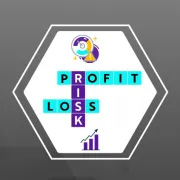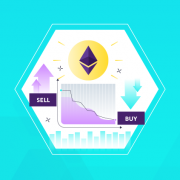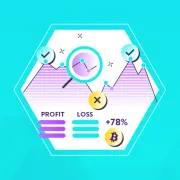Trading indicators are essential trading tools used to gauge past and present financial trends. It is no news that predicting the outcome of future trends in the market can be very challenging. But with the right indicators, this task can be made easier. This piece will be exploring the best crypto trading indicators you can use to improve trading.
Article summary
What are trading indicators?
Indicators are used by traders to provide more clarity on market trends. The use of indicators has served as a profitable trading strategy. It takes data from the previous state of the market and uses them to predict the future market state.
A trading indicator can either be: leading or lagging. Leading indicators predict the price action of a trade while lagging indicators show previous reports of a trade. Both indicators can be merged and employed to make trading decisions.
What are technical indicators?
Technical indicators are patterns that traders use to predict price movements. As a trader, you may use technical indicators to understand the way price movements work in the market.
The accuracy of technical indicators is questionable without a doubt. This has struck a question to technical analysts: Do technical indicators really work? When it comes to crypto technical analysis indicators, accuracy is not 100% guaranteed. But the goal is to have more accurate predictions than inaccurate ones, obviously. Once that is accomplished, technical indicators can create winning strategies.
What are the best crypto indicators for technical analysis?
Regardless of the numerous trading indicators, people still look out for the one that is just right. Choosing the best technical indicators for bitcoin, ethereum and other crypto assets can greatly improve the accuracy of price predictions and overall trading performance.
Here are the best indicators for crypto trading you can use:
Moving Average Convergence Divergence (MACD)
What is MACD?
MACD is an acronym and stands for Moving Average Convergence Divergence. MACD represents the average price of an asset over a particular period.
The two types of MACD are simple moving average (SMA) and exponential moving average (EMA). Calculating a simple moving average requires you to find the average of prices of securities through a particular time frame. The EMA, on the other hand, is calculated in a similar way. The difference between these two is that EMA places more emphasis on recent prices.
How to read a MACD chart?
Here are a few things to note when learning how to read a MACD chart:
- MACD comprises three major lines: MACD line, signal line, and zero line.
- There is an uptrend when the MACD line rises over the zero line.
- There is a downtrend when the MACD line falls below the zero line.
- A bearish movement occurs when a MACD line dips below a signal line. A trade is said to be bearish when there is a continuous decline in price action. This is an indication that a trader should sell to avoid further losses.
- Conversely, a bullish movement occurs when a MACD line rises above a signal. A trade is said to be bullish when there is a continuous rise in price action. This is an indication that a trader should sell to make returns.
Relative Strength Index (RSI)
What is RSI?
RSI is an acronym that stands for relative price index. It is an indicator that evaluates past and current price movements to determine securities that are overbought or oversold.
An asset is said to be overbought when it has experienced a rapid uptrend within a short period. This occurs when the demand for an asset increases. The rise in demand thereby causes a relative increase in price that rises above the upper band.
An asset is said to be oversold when it has experienced a rapid downtrend within a short period. The price of an oversold asset is usually below its true value which leads to an increase in supply.
How to read RSI indicator?
Now that you know how it works, you can now learn how to read RSI. RSI uses an oscillator that has an upper boundary of 100 and a lower boundary of 0. The RSI is overbought when its level is above 70. Conversely, it is oversold when its level is below 30. To determine the RSI of an asset, you need to understand the calculations behind it.
Here is a step-by-step guide on how to calculate RSI:
- Determine the upward change (U) and downward change (D).
- Find the average of the Upward change (AVgU) and the average of the downward change (AVgD).
- Calculate the Relative Strength (RS).
- Find the RSI using this formula:
RSI= 100–100/(1+RS).
On-Balance Volume
What is OBV?
OBV is one of the best indicators for crypto trading that stands for On-Balance Volume. OBV shows the relationship between trading volume and price, and how one affects the other. Joseph Granville brought this indicator into the limelight and used a spring analogy to describe it. He explained that when there is a sudden increase in trading volume without a price change, the price would eventually rise or fall.
When choosing this indicator, you need to have a proper understanding of how to use and read OBV. Here are the main instances to look out for when reading OBV charts:
- An uptrend can occur when there is a decrease in price and an increase in OBV. This is known as a bullish divergence.
- A downtrend can occur when there is an increase in price and a decrease in OBV. This is known as a bearish divergence.
How to calculate OBV?
The calculation for OBV depends on the situation of the trade. Here are the three possible scenarios and their respective calculations.
- When the present closing price of an asset is greater than that of the previous day:
OBV= Previous day OBV+ Present volume
- When the present closing price of an asset is the same as that of the previous day (no change):
OBV= Previous day OBV
- When the present closing price of an asset is less than that of the previous day:
OBV= Previous day OBV- Present volume
Bollinger Bands
What are Bollinger Bands?
Bollinger bands is a type of crypto chart indicator that assists traders in navigating trading entry and exit points. A major element employed in the use of Bollinger bands is the standard deviation. Standard deviation is simply how far apart the current price of an asset is from its usual price. In trading, prices tend to deviate as a result of volatility. But there is usually an average point at which the price falls. Standard deviation is measured by how much the price moves closer or further from the average price point. Bollinger bands are good examples of a buy-sell indicator.
How to read Bollinger Bands?
When learning how to read Bollinger bands, you need to consider the things that make up the chart. Here are the major things you would find in a Bollinger band:
- The lower band
- The upper band
- The middle band
The middle band represents the average price of an asset. The lower band represents the lowest point in which the price is expected to move while the upper band represents the highest point in which the price is expected to move. The upper and lower bands of the indicator contract with decrease in price and expands when there is an increase in price.
Bollinger band is also a means to determine if an asset is overbought or oversold. The price of an asset is overbought when it moves towards the upper band. Meanwhile, the price of an asset is oversold when it moves towards the lower band.
Although this indicator is widely used, people often wonder how accurate are Bollinger bands? Just like many other indicators, Bollinger bands are not 100% accurate. Not all data produced by Bollinger bands are correct but the indicator has proven true many times. A trader should also use their knowledge and precision when using this indicator.
Ichimoku Cloud
What is an Ichimoku Cloud?
An Ichimoku Cloud is an indicator used to measure support and resistance levels and other relevant data, including trading momentum. The Ichimoku cloud chart contains so much information that with just a glance, you can decipher a lot. But attaining this level of understanding is not easy as the charts may seem complicated. This is why you need to learn how to use and read the Ichimoku cloud.
How to use Ichimoku Cloud?
Here are some things to note when you want to use Ichimoku Cloud:
- The Ichimoku cloud has two major lines. The leading span A line, as well as the leading span B, work hand in hand.
- There is an uptrend when the leading span A rises above the leading span B. This is known to be a bullish indicator.
- There is a downtrend when the leading span A dips below the leading span B. This is known to be a bearish indicator.
- An uptrend is about to occur when the cloud turns green. Conversely, a downtrend is about to occur when the cloud falls downward and turns red.
- Together with the Leading Spans, Ichimoku Cloud indicator also plots a Conversion Line, a Base Line and a Lagging Span.
Having seen the features of the Ichimoku cloud, one might ask: does the Ichimoku cloud work? The answer lies in the numerous testimonies of traders that have used this indicator. It has been known to be very effective and reliable. Even greater results are reaped when paired with other indicators like RSI.
Moving Average
What is the Moving Average?
A moving average is an indicator that uses the average price of future trends to determine present ones. It is calculated by adding all the prices of a security over a period, y and dividing it by the number of periods, y. A moving average indicator is continuous because it is frequently calculated.
The two main types of moving average traders use are Simple Moving Average (SMA) and Exponential Moving Average (EMA). The SMA calculates the average price of a security over a particular time frame. The EMA performs the same operation but lays more emphasis on recent prices during calculation.
How to use Moving Average?
A moving average can determine when an asset is experiencing an uptrend, downtrend or when it is ranging. When the price rises above the moving average line, it is a signal to buy. But if it falls below the line, it is a signal to sell.
Divergences
What are divergence indicators?
A divergence occurs when the price of a security moves in an opposite direction with the indicator. Just from the look of it, divergence sounds like a strange concept. But the truth is, it can either be positive or negative! A divergence is positive when the price of an asset hits a low but the indicator hits a rise in price. This signifies that there is a possible uptrend coming soon. Likewise, a divergence is negative when the price of an asset is high and the indicator signifies a low.
How to use a divergence indicator?
- A good indication to take action is when you spot a divergence (either bearish divergence or bullish divergence). If you have the patience and nerves to wait for a triple divergence, or even a quadruple one, then the market will reward you.
- A stop-loss order can be placed when the price reaches a certain level against you to avoid further losses.
- Timely price confirmation is important in determining the right entry point.
Now that you have learned about the best indicators for crypto trading, you can now put them to use. Note that you can use more than one indicator simultaneously. But to do so, a proper understanding of indicators is needed. This article is your ultimate guide in tackling decisions relating to the best indicators for crypto trading, what they are and how to use them.

Ebiere Watchman is a prolific writer specialized in web 3.0 and finance. Ebiere’s experience includes research projects, sales copywriting, and storytelling. She prides herself in crafting impeccable content to drive mass adoption in cryptocurrency.








